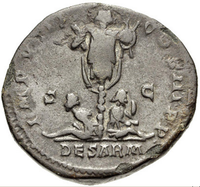Tropaion
In the Greek city-states of the Archaic period, a tropaion would be set up on the battlefield itself, usually at the site of the "turning point" (Gk.
The monument would be dressed in the typical hoplite panoply of the period, including (at different times), a helmet, cuirass (either of bronze or linen), and a number of shields, etc., would be piled about the base.
It remained on the battlefield until the campaigns of the following seasons (since battles often were fought in the same, relatively few plains amid Greece's numerous mountains), whereupon it might be replaced with a new trophy.
During later eras in the Greek world, intention to build a tropaia might be declared at the battlefield, but in fact, erected at pan-Hellenic sanctuaries such as Olympia or Delphi, further increasing the prestige of the victorious state.
[3] Ancient sources attest to the great deal of significance that early Greek cities placed upon symbols and ritual as linked to warfare – for example, the story in Herodotus 1, involving the bones of Orestes that greatly exceeds the ritualistic properties to even magically 'guaranteeing' the Spartan victory, displays the same sort of interest in objects and symbols of power as they relate to military success or failure.


